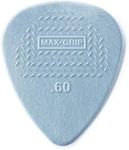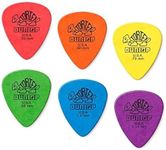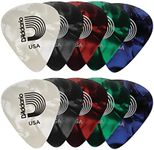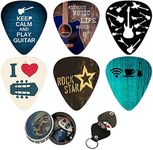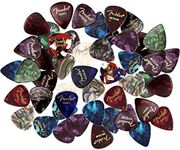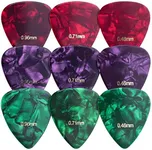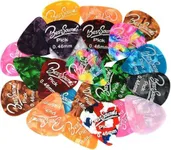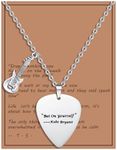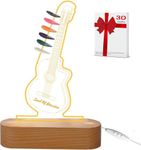Buying Guide for the Best Guitar Picks
Choosing the right guitar pick can significantly impact your playing experience and sound. Guitar picks, also known as plectrums, come in various shapes, sizes, materials, and thicknesses. Each of these factors can influence your playing style, comfort, and the tone produced by your guitar. Understanding these key specifications will help you select the best pick for your needs.MaterialThe material of a guitar pick affects its durability, flexibility, and the sound it produces. Common materials include plastic, nylon, celluloid, and metal. Plastic picks are versatile and durable, making them a popular choice for many players. Nylon picks are flexible and provide a warmer tone, suitable for strumming. Celluloid picks offer a classic feel and bright tone but can wear out quickly. Metal picks are very durable and produce a bright, sharp sound, ideal for heavy playing styles. Choose a material that complements your playing style and the sound you want to achieve.
ThicknessThe thickness of a guitar pick, measured in millimeters, affects its flexibility and the sound it produces. Thin picks (0.38-0.73 mm) are flexible and produce a lighter, brighter sound, making them ideal for strumming and rhythm playing. Medium picks (0.73-0.88 mm) offer a balance between flexibility and stiffness, suitable for both strumming and lead playing. Thick picks (0.88-1.5 mm and above) are stiff and produce a fuller, more powerful sound, preferred by lead guitarists and those who play fast, intricate passages. Consider your playing style and the type of music you play when choosing the thickness of your pick.
ShapeGuitar picks come in various shapes, each offering different levels of control and comfort. Standard picks have a teardrop shape and are versatile for most playing styles. Jazz picks are smaller and have a pointed tip, providing precision and speed for lead playing. Triangle picks are larger and offer a better grip, suitable for players who need more control. Finger picks are worn on the fingers and are used for fingerstyle playing. Choose a shape that feels comfortable in your hand and suits your playing technique.
GripThe grip of a guitar pick refers to how easily it can be held without slipping. Some picks have textured surfaces or holes to improve grip, which can be especially helpful during long playing sessions or for players with sweaty hands. Picks with a good grip can provide better control and reduce the likelihood of dropping the pick while playing. If you find that picks often slip from your fingers, consider trying ones with enhanced grip features.
SizeThe size of a guitar pick can affect your playing comfort and control. Smaller picks can offer more precision and are often preferred by lead guitarists for fast, intricate playing. Larger picks provide a better grip and are easier to hold, making them suitable for rhythm playing and beginners. The right size for you will depend on your hand size and playing style. Experiment with different sizes to find the one that feels most comfortable and provides the best control for your playing.

